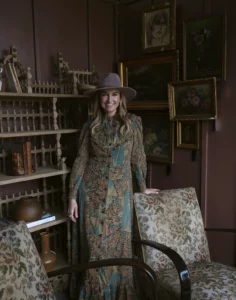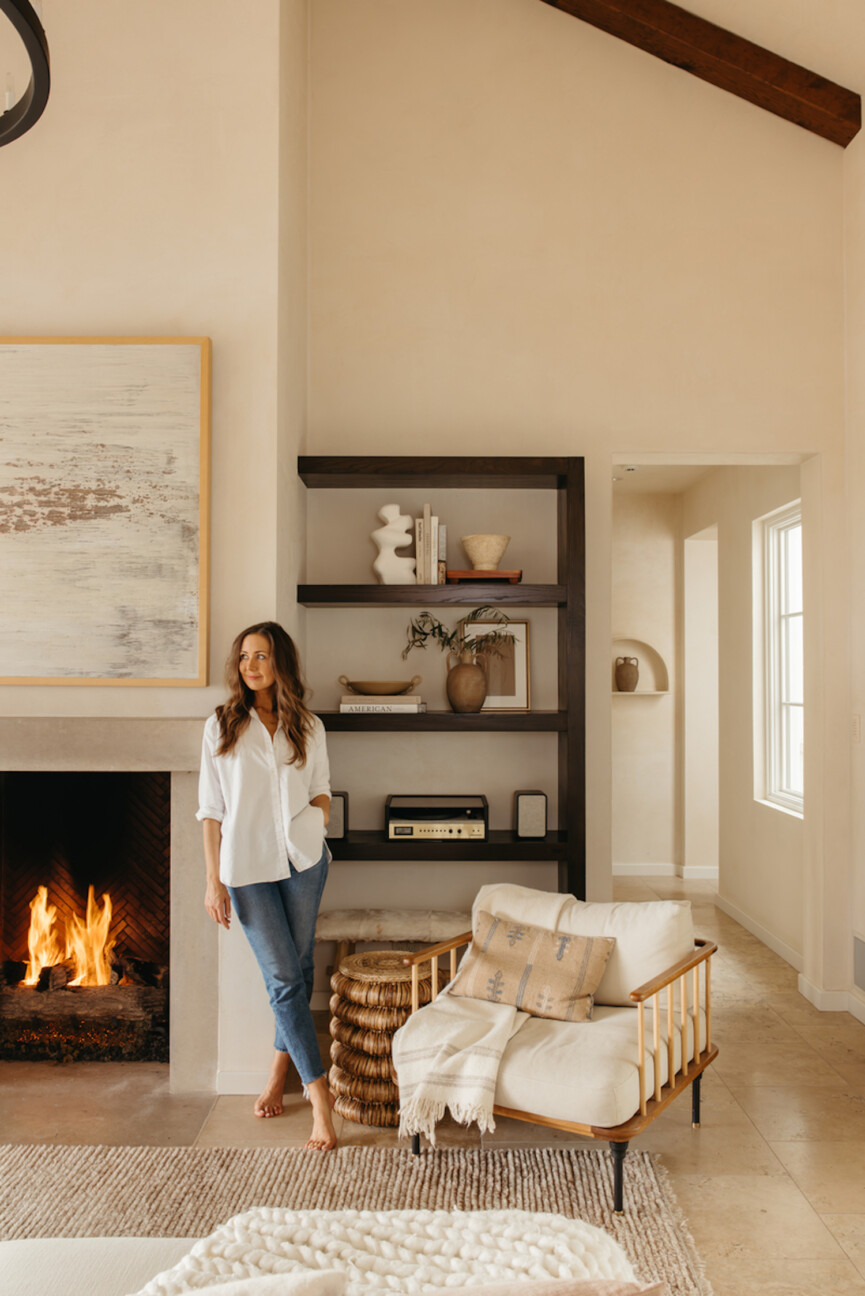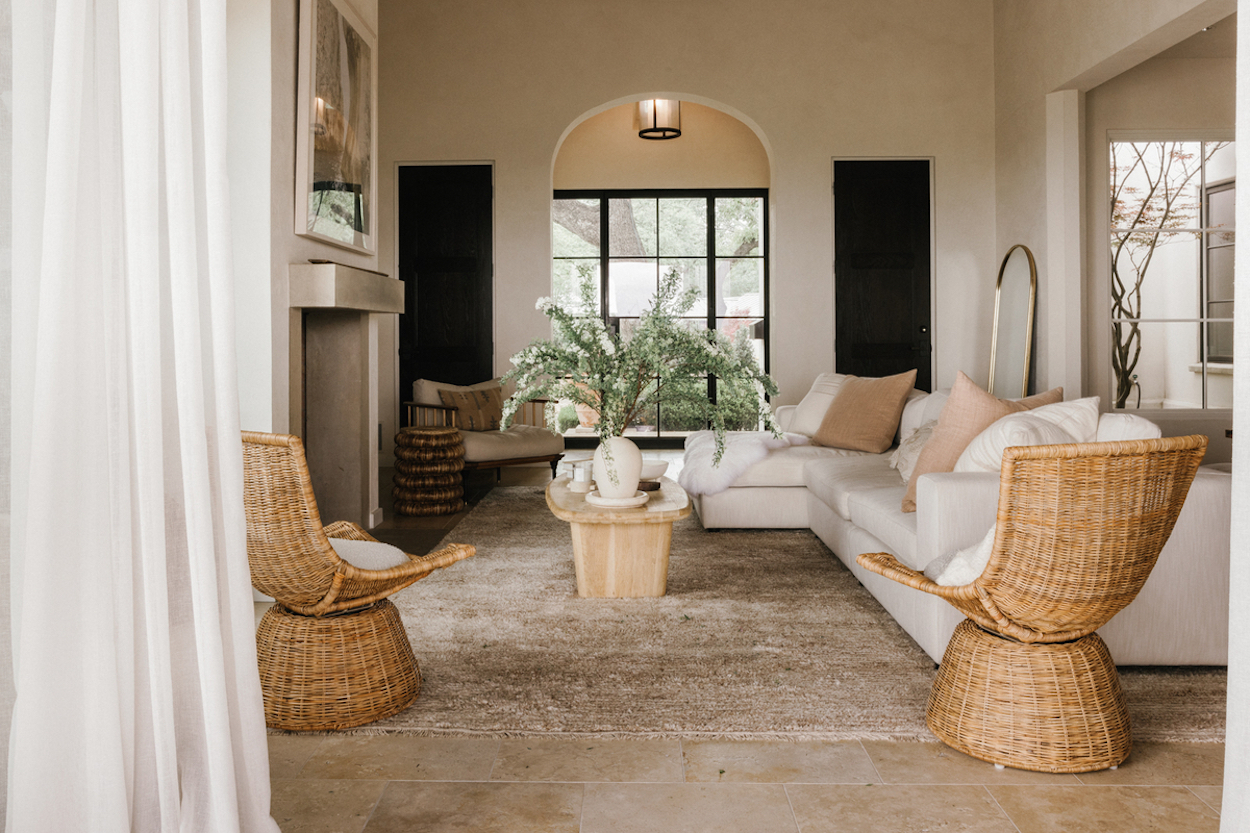If you’re a fan of cozy interiors, you’ve most likely fallen for rattan. As you scroll through interiors on Instagram or even as you walk the aisles of any home goods store, pops of this warm, golden brown material can be found in everything from lamps, chairs, and outdoor furniture sets. At first glance, rattan may remind you of the effortless ease that comes with beachy or bohemian homes, but now more than even, rattan pieces are being incorporated into traditional and modern spaces as well. It’s hard to resist the laid-back beauty rattan exudes, which is why we’re seeing it just about everywhere these days.
Perhaps you’ve wondered though: what is rattan? Why is it all of a sudden so popular? And how can I style it in my own home? If you’re looking for a deep dive into all things rattan, you’ve come to the right place. Here’s everything you need to know about this versatile and beautiful material.
What is rattan?
First things first. Rattan is a hardy climbing plant native to Southeast Asia. There are hundreds of species of rattan palm, and they grow strong and tall—we’re talking hundreds of feet. Once rattan palm stems are harvested and their outer bark is stripped, the wood is sturdy and lightweight, making it an ideal material for making furniture, woven baskets, and other homewares. The different species of rattan come in a variety of colors spanning light tan, deep gold and reddish-brown. Once this durable palm is made into furniture, these high quality pieces are built to last if taken care of properly.
Rattan’s Defining Elements and Characteristics
Rattan furniture is known for being strong, durable, and beautiful. It has been around for centuries, and if you’re lucky, you can also score vintage rattan pieces in excellent condition. Rattan was especially popular in the 1970s and has been making its mark in the interior design world again, thanks to its eco-friendly nature and robustness.
“As an interior designer who values natural materials, rattan furniture is prevalent in our design plans. Its organic charm and tactile appeal add depth and warmth to any space,” Audrey Scheck of Audrey Scheck Design shares. “Rattan pieces add a textural layer to interiors and effortlessly blend with other natural elements like wood, stone, and linen.

Audrey Scheck
As the founder and principal designer of her eponymous design firm in Austin, Audrey has established a reputation as an expert in transforming residential and commercial environments. Audrey and her team have a wide-ranging portfolio that has been featured in Martha Stewart, Better Homes & Gardens, Real Simple, Southern Living, and Forbes.

The Difference Between Rattan and Cane, Bamboo and Wicker
Woven materials like rattan, cane, bamboo, and wicker are all very similar, and are even used interchangeably—but are they all the same? Not exactly. At first glance, wicker and rattan could easily be mistaken for each other, but wicker refers to the weaving pattern of the material. Wicker is often made from rattan, but can also be woven with bamboo, willow, or synthetic fibers.
It’s easy to see the similarities between rattan and cane, because they both come from the same plant. Cane refers to the outer bark that is stripped from the rattan vine and is often used as accents in wood furniture, while rattan is the inner core of these vines. And even though rattan and bamboo may look similar, they are very different plants. Bamboo is a hollow grass that can’t bend or curve, whereas rattan is solid and flexible.
How to Shop for Rattan Furniture
Shopping for rattan pieces can be as easy as browsing the aisles at Target, or scouring your local flea. Due to the popularity of these pieces, you’re more than likely to see rattan furniture at thrift stores and consignment shops. If you’re looking for a vintage gem, Scheck recommends inspecting the quality of the rattan first and foremost. “When shopping for rattan furniture, especially vintage pieces, it’s encouraged to inspect for any signs of wear and tear, such as loose weaving or structural damage,” she says. If you want to be sure you have an authentic piece of rattan, it’s best to find a professional or expert. “Look for reputable sellers or dealers who specialize in handmade furniture to ensure authenticity and quality,” Scheck encourages.
It’s also easy to spot brand new rattan pieces, and Scheck recommends keeping sustainability top of mind. “When purchasing new rattan furniture, opt for sustainable sources and consider factors like warranties and return policies to make an informed decision on your purchase,” she says.

How to Style Rattan Pieces in Your Home
Lamps
“Rattan lamps can instantly make a vignette more interesting, and they are timeless enough to pair with nearly any aesthetic,” Scheck shares. Adding rattan lighting will bring additional warmth and charm to your living room, bedroom or office space, and can blend in seamlessly with other textures and materials. Try adding a rattan table lamp to any of the rooms in your home for a touch of elegance and charm.
Chairs
There’s something about a rattan chair seated next to a cream colored sofa that instantly creates a homey environment. It beckons you to relax and stay awhile. Whoa doesn’t want that in their home? Consider rattan chairs for your living room if you’re looking for added texture, or try including rattan chairs to an otherwise formal space (think dining rooms or home offices) for an unexpected dash of whimsy and playfulness. Keep it rustic with a faux sheepskin throw or plaid textile, or go with a soft blue or crisp white throw pillow to keep it beachy for summer.
“Whether it’s a vintage armchair or a modern coffee table, rattan pieces bring a sense of authenticity and coziness to a room,” Scheck states.
Side Tables
If larger rattan pieces like chairs or sofas feel a bit much to start, consider rattan accents like side tables. Incorporating too many rattan pieces may make your space feel a bit dated anyway, but using rattan with other materials, textures, and colors will add the perfect amount of contrast. Keep in mind that rattan comes in a variety of shades, from light beige to golden brown, so be on the lookout for a shade of rattan that works well with your other furniture and decor.
Beds
If there’s one single rattan statement piece to invest in, let it be a bed frame. Rattan looks best when paired with nature-inspired hues and calming bedroom color palettes fit in well with its natural beauty. Adorn your rattan bed frame with linen bedding, strew house plants around the room, and let plenty of sunshine in. All of these natural elements will complement the rattan, and will no doubt create a relaxed, cozy bedroom.
Cabinets
Since rattan is neutral, the design possibilities are endless for a striking piece like a rattan cabinet. Do you want your space to be coastal and beachy? Tuck a rattan cabinet among an oatmeal linen chair and a blue throw. Prefer a boho vibe? Store ceramics on your cabinet shelves, place a large leafy green plant next to it and include it in a warm color palette of pinks and oranges. Rattan even works with dark and moody walls, exposed brick or masculine textures like leather—a fantastic option, no matter your design preferences.
Sofas
Rattan is perfect for both indoor and outdoor spaces, and a rattan sofa makes an excellent statement whether it’s in your living room or back deck. If you’re thinking of adding rattan furniture to your outdoor living space, continue to style with opposing textures, just like you would inside.
“Mixing rattan with other materials like wood and patterned textiles will create visual interest and a layered look,” Scheck says. If you do decide on an outdoor rattan sofa, just be sure to keep it dry and out of direct sunlight. These preventative measures will keep the fibers from weakening under harsh rays, and save it from mold and warping as well.

